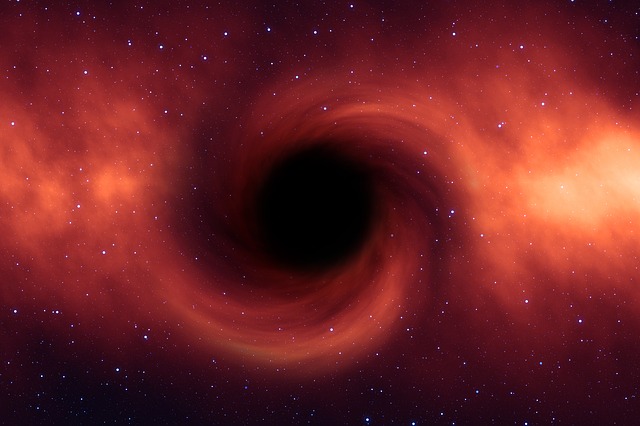*This post may contain affiliate links. This means we may make a commission if you purchase an item using one of our links*
The spin of a black hole can achieve a speed close to that of light. The reason for this is that black holes begin life as spinning stars. As the star transforms into a black hole, its mass is concentrated into a much smaller area, and the rotation speed must increase to balance the angular momentum.
Continue reading to discover how fast black holes spin and whether this rotation can slow down. You’ll also learn which types of black holes don’t spin and whether the status of a black hole stays the same forever.
How Fast Does A Black Hole Spin?
Table of Contents
Black holes are among the universe’s biggest mysteries: what do they look like? Are they infinitely dense? What lies beyond the event horizon? There are so many questions that we still can’t answer. One thing we do know is that these dark space oddities are massive and spin around at incredible speeds.
These giants can spin at incomprehensible spin rates. For example, the black hole in the center of the galaxy NGC 1362 is spinning at 84% of the speed of light.
Before the formation of the black hole existed a massive star that formed from a solar nebula. This celestial body rotated thanks to the momentum of the particles in the dust-filled cloud. And as gravity pulled the star’s body together, the angular momentum caused its body to rotate more rapidly.
Can A Black Hole’s Rotation Slow Down?

When a star transforms into a black hole, it still holds its original mass, but that mass is now concentrated in a much smaller space. So, to conserve the angular momentum, the rotation rate must increase significantly.
Based on this information, it’s easy to assume that the spin rate could increase to an infinite amount if the hole were small enough, but this is not the case; black holes have a spin speed limit.
This limit is set by the event horizon of the black hole. Imagine the event horizon as a sphere; surrounding this sphere is the ergosphere, and the faster the black hole spins, the more it flattens out.
At a high enough speed, the black hole would reach a singularity. Still, a naked singularity is impossible as it could emit light or energy, allowing outsiders to see it. In essence, the maximum speed limit is reached when the angular momentum and mass of the black hole are equal.
Do Black Holes Spin Forever?
According to the theory of general relativity, a black hole will last forever, and nothing can escape it. However, when we add quantum mechanics to the mix, we realize that black holes could eventually evaporate from existence through Hawking radiation.
In this theory, the lifespan of a black hole depends mainly on its mass, with smaller black holes disappearing several billion years before larger black holes.
If Professor Hawking’s theory is true and black holes lose mass over time; then they could hypothetically slow down. Remember the maximum speed of a black hole exists as a balance of angular momentum and mass; if you decrease the object’s mass, you may also reduce the speed.
Other theoretical processes, such as the Penrose Process, also detail how energy could be extracted from a black hole. As this happens, the angular momentum decreases as the process repeats itself until the black hole becomes a non-spinning Schwarzschild.
Why Do Some Black Holes Not Spin?
Scientists often classify black holes by their mass, but we can also group them by rotation and charge. In this scenario, we have the following categories:
- Schwarzschild Black Hole or a static black hole. This type of black hole has no spin or charge and is characterized only by its mass.
- Kerr Black Hole. A black hole that does rotate but possesses no electrical charge.
- Reissner-Nordstrom Black Hole. A black hole that is charged but not rotating.
- Kerr-Newman Black Hole. A black hole that is both charged and rotating.
Black holes, as we know them, are formed from the collapse of a spinning star, whose angular momentum causes the black hole to spin faster as the mass becomes increasingly concentrated.
In theory, a non-rotating star could create a non-rotating black hole, but astronomers are yet to prove their existence. It’s possible this could be the case, but it’s unlikely.
Any mass could become a black hole if it could achieve sufficient compression. The radius of the event horizon in a non-rotating black hole is termed the Schwarzschild radius; this marks the point of no return where the escape velocity equals light speed.
For mass to successfully become a black hole, its physical size must be less than the Schwarzschild Radius. For our Sun, this would mean condensing to a sphere with a maximum width of 2.5km; Earth would have to possess a diameter of less than 1.77cm.
The geometry of the Reissner-Nordstrom black hole was discovered by these two scientists, independent of one another, in 1916 and 1918, respectively. This model proposes a charged black hole, which is unlikely to occur in our electrically neutral universe. More likely, a charged black hole would quickly attract the opposite particles and neutralize them.
Still, it’s interesting to examine the mathematics of a Reissner-Nordstrom black hole as it provides a solution to an enclosed white hole (and thus wormholes and time travel). Although intriguing, this type of wormhole would be too violently unstable to occur in reality.
Conclusion
Several scientists have theorized different black holes that hold variations on charge and rotation. Still, today’s reality is that black holes evolve from spinning stars and thus spin themselves for the entirety of their lives. Thanks to the extreme mass concentration, a black hole’s spin speed can get close to the speed of light.
References
How fast do black holes spin? (phys.org)
Black Hole | COSMOS (swin.edu.au)
Journey into and through a Reissner-Nordström black hole (colorado.edu)


If in the depth of a black hole as predicted by math that the rules of physics break down we will never know what phenomenon is controlling it’s continuation termination or existence there is not yet enough understanding of what is happening at the sub atomic level.